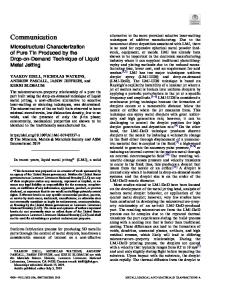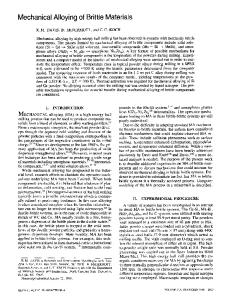Microstructural Characterization of Multi-Component Systems Produced by Mechanical Alloying
- PDF / 310,106 Bytes
- 6 Pages / 432 x 648 pts Page_size
- 7 Downloads / 345 Views
Mater. Res. Soc. Symp. Proc. Vol. 1243 © 2010 Materials Research Society
Microstructural Characterization of Multi-Component Systems Produced by Mechanical Alloying R. Pérez-Bustamante1, C.D. Gómez-Esparza1, F. Pérez-Bustamante2, I. Estrada-Guel 1, J.G. Cabañas-Moreno3, J.M. Herrera-Ramírez1, R. Martínez-Sánchez1 1 Centro de Investigación en Materiales Avanzados (CIMAV), Laboratorio Nacional de Nanotecnología, Miguel de Cervantes 120, 31109 Chihuahua, Chih., México. 2 Instituto Tecnológico de Chihuahua (ITCH), Av. Tecnológico 2909, 31310 Chihuahua, Chih., México. 3 Instituto Politécnico Nacional – CNMN, UPALM, 07338 México, D.F., México. ABSTRACT A series of binary to hexanary alloys (Ni, Co, Mo, Al, Fe, Cu) are produced by mechanical alloying. Formation of an FCC solid solution is observed in the binary system. For ternary to quinary systems the presence of an amorphous phase and a BCC solid solution is identified, and for the hexanary system a combination of BCC and FCC solid solutions is detected. There is a very small change in the lattice parameter of Mo, reflecting the limited solid solubility of other element in this structure. However, Mo induces the fast amorphization of other elements and the reduction of crystallite size. INTRODUCTION Multi-component systems are characterized by a high entropy and ability to form amorphous phases [1-5]. High entropy alloys (HEAs) are a new era of materials that consist of various major alloying elements; the system selected in each case is different, and each additional element changes the behavior of the final alloy. The HEAs are quite simple to analyze and control because they tend to form simple solid solution phases, mainly of FCC and BCC structures. They have numerous beneficial mechanical, magnetic, and electrochemical characteristics [6]. These systems can be processed by different routes, conventional casting, thin film deposition and milling process. The mechanical alloying (MA) process has been widely recognized as an alternative route for the formation of nanocrystalline materials, with unusual properties [7, 8]. In this investigation, a multi-component system formed by Ni-Co-Mo-Al-Fe-Cu is studied from the binary to hexanary alloy; the effect of each element and milling time is reported and discussed. EXPERIMENTAL PROCEDURE Ni, Co, Mo, Al, Fe and Cu powders with purity higher than 99.5% and particle size of 325 mesh are mechanically alloyed from binary Ni-Co to hexanary Ni-Co-Mo-Al-Fe-Cu systems in equiatomic ratio. Table 1 gives the nominal composition used in each system (identified as A, B, C, D, E series). The milling process is carried out from 0 to 30 h in a high energy shaker ball mill (SPEX-8000M). Hardened steel vials and balls are used as milling media. The milling ballto-powder weight ratio is set at ~5:1. In order to avoid excessive welding of powders, methanol is added to the powders to act as a process control agent (PCA). The milled products are characterized by scanning electron microscopy (SEM) in a JEOL JSM-7401F microscope
supplied with
Data Loading...











